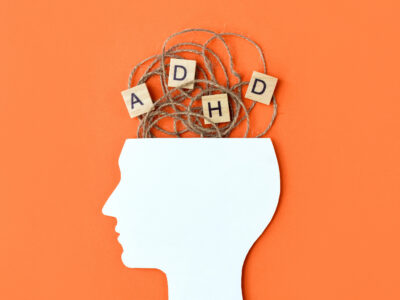Many children and adults deal with attention deficit/hyperactivity disorder (ADHD), a condition affecting one’s focus, attention, and ability to perform cognitive tasks, with or without accompanying symptoms of restlessness and hyperactivity. The typical conventional treatment options are amphetamine-derived drugs which produce effects similar to methamphetamine and cocaine. Indeed, they are so effective for promoting short-term focus that like methamphetamine and cocaine, they are traded illicitly among college students and shift workers to enable short bursts of productive activity, with the same addictive potential and harmful side effects. All of these drugs work along similar lines to potentiate the effects of dopamine and norepinephrine in the brain, and can treat ADHD on a superficial level because all of the symptoms of that disorder can essentially be reduced to a deficiency of these neurotransmitters in the brain. Dopamine is required for long-term planning and delayed gratification, as well as the ability to keep the body still – the reason why loss of dopaminergic neurons causes resting tremors in Parkinson’s disease. Norepinephrine is crucial to maintaining sustained attention and vigilance, and is required for alertness, learning, and memory. Not only will maximizing these neurotransmitters in the brain improve cognitive performance, it will essentially reverse ADHD, to the extent that ADHD can basically be thought of as a deficiency disorder. While conventional medicine recommends drugs with dopamine-like effects to correct this deficiency, the true deficiency in ADHD is more likely nutritional, and maximizing the intake of certain nutrients through diet can essentially achieve the same results without harmful side effects. Synthesizing quantities of neurotransmitters adequate to maintain normal brain function requires a suite of important nutrients typically lacking in modern diets, because the body requires these nutrients to generate neurotransmitters from their amino acid bases. Four primary dietary changes, all supported by research, together have the potential to cure ADHD without the use of pharmaceuticals, as will be discussed in depth below. They include increasing intake of vitamin B6 and magnesium, iron, zinc, and eliminating most artificial food colorings.
Eat More Foods Rich in Magnesium and Vitamin B6
There is good reason to believe that increasing magnesium and vitamin B6 in the diet can be as useful as pharmaceutical drugs in the treatment of ADHD. The rationale for using magnesium has to do with its role in stabilizing ion flux across neuronal cell membranes. Most importantly, having a lot of magnesium within a cell helps balance and regulate the flow of another ion, calcium. The reciprocal nature of these two minerals and the necessity of keeping them balanced is well known, and yet magnesium is rarely considered important for brain health, even though calcium balance is exquisitely important for brain function. In the nervous system, calcium ions create "excitatory" potentials, the theory being that low magnesium levels will result in consequently high calcium levels or in other words, an "overly-excitable" brain which becomes prone to hyperactivity. Magnesium also, as stated above, enhances the absorption of vitamin B6. The rationale for using vitamin B6 involves its crucial role as a cofactor in creating neurotransmitters, including dopamine and norepinephrine. This is an interesting association given that the drugs Adderall and Ritalin are thought to work by prolonging the effects of these neurotransmitters in the brain, because when these neurotransmitters are underactive, classic ADHD symptoms tend to result. When symptoms suggest a neurotransmitter deficiency, the allopathic approach is to give drugs like Adderall and Ritalin that mimic these neurotransmitters in the brain, ignoring the root cause, when often the problem can be solved by simply providing the body with the nutrients it needs to make enough of its own neurotransmitters.
The benefits of vitamin B6 and magnesium for treating ADHD are not merely theoretical. Research has shown that supplementing these nutrients together, in amounts standardized to each child’s body weight (6mg/kg magnesium, 0.6mg/kg B6), significantly improved symptoms of hyperactivity and aggressiveness in school-aged children with ADHD1. We know that magnesium is often deficient in the standard American diet, and it should come as no surprise that vitamin B6 can treat ADHD given that there is a drug approved for treating ADHD in adults called Metadoxine, which is essentially nothing more than brand-name prescription Pyridoxine, i.e. vitamin B6. A simpler approach is to simply eat more B6-containing foods.
Increase Iron Intake
Iron deficiency remains the single most common nutrient deficiency worldwide, affecting an estimated 40-50% of young children in developing countries, and it should not be taken for granted that children anywhere in the world are getting enough iron simply because they are not impoverished. This is especially true of children who are restless or struggle to remain focused, as these can actually be considered early warning signs of iron deficiency. It is important to remember that the iron used in multivitamins and to fortify foods or infant formula is not easily absorbed, and most blood tests for iron deficiency are actually screening for frank anemia, which only appears in cases of severe deficiency. While the primary function of iron in the body is to carry oxygen in red blood cells, it is less well known that iron plays a crucial role in the function of neurotransmitters. For example, iron deficiency in the brain has been shown to reduce binding sites for the neurotransmitter dopamine. Most pharmaceutical treatments for ADHD work by increasing dopamine levels in the brain, but what if the problem is not a lack of dopamine, but simply a lack of dopamine receptors as a consequence of iron deficiency? Research shows that compared to healthy children, kids with ADHD tend to have lower ferritin levels, an early sign of iron deficiency, and that iron supplementation improves ADHD symptoms in such children2.
The reason even a mild iron deficiency can cause ADHD symptoms involves the role of iron in dopamine synthesis. Iron is a necessary cofactor for the enzyme tyrosine hydroxylase, the rate-limiting enzyme in the conversion of tyrosine into dopamine. Since dopamine is required for goal-oriented behavior and long-term focus, a mild iron deficiency in the brain will limit the rate of dopamine synthesis and cause symptoms of ADHD. That ADHD is essentially a deficiency of dopamine in the brain can be easily inferred from the fact that the drugs for treating ADHD work by increasing dopamine in the brain. Thus, a diet sufficiently high in iron, as well other important nutrients like magnesium and vitamin B6, can effectively treat ADHD and make these drugs unnecessary.

Increase Zinc Intake
If any mineral is more important to the brain than iron, it would be zinc. Not only does zinc in the brain regulate the release of other neurotransmitters, it may even be a neurotransmitter, modulating neuronal excitability and essentially stabilizing brain function. It should be obvious that such a mineral could help to focus a distractable, hyperactive brain, yet the scientific evidence for this working remains equivocal, with benefits shown in some cases but not in others. There are some studies showing that serum zinc levels are reduced in ADHD, and increasing intake of zinc reduces symptoms. That the results are mixed suggests that zinc is one of but not the only factor needing to be considered and addressed. One of the biggest issues with scientific research is a tendency to overgeneralize, concluding a treatment to be ineffective if the results are inconsistent rather than trying to explain why it will work in some cases but not in others3. One of the best studies demonstrating zinc to be effective for ADHD found the benefit was greatest in older children with low serum zinc levels, as opposed to younger children showing no signs of zinc deficiency4, a result which should be obvious but is unfortunately glossed over in many larger trials. Specifically, zinc seems to be more important for post-pubescent children whereas prepubescent children often need more iron. This is because different stages of life put different demands on the body’s nutrient stores, with sexual maturity initiating many zinc-dependent processes as other forms of growth begin to slow.
Eliminate Artificial Food Additives
There is a lot of anecdotal evidence that artificial food dyes, especially red dye #40 for some reason, can be a cause of behavioral problems in some sensitive children. Unfortunately however, this is a point that mainstream health authorities tend to deny. The reason for this (besides probable strong pressure from the food industry) is that while preliminary evidence from the 1970s initially demonstrated a clear link between certain food additives and hyperactivity, the larger trials that followed failed to reproduce similarly strong evidence. Thus, most devotees of evidence-based medicine will claim there is no evidence that food additives cause behavioral problems, even though there are in fact some studies, including some recent ones, which continue to show a link. The truth seems to be that food dyes will trigger or worsen ADHD symptoms in some children but not others, with individual susceptibility playing a large role. At least, this was the conclusion of a large meta-analysis of fifteen such trials exploring this effect5. The danger of food additives depends to a large extent on the overall quality of the diet, particularly one’s iron and zinc intake, which likely explains how some children can eat them with seeming impunity while others develop symptoms. For anyone hoping to improve brain health or optimize cognitive performance, however, eliminating synthetic food dyes should be considered essential.
To truly appreciate why food additives are so bad for the brain, and why eliminating them is so important in the treatment of behavioral disorders, it is necessary to understand what food dyes actually do inside the brain. The majority of food colorings used today, especially red and blue dyes, are synthetic chemicals with the dangerous ability to cross the blood brain barrier. Because brain function is so exquisitely sensitive to minor chemical alterations, the blood brain barrier is supposed to tightly regulate what sort of molecules are allowed to come in and out. Many synthetic chemicals are a problem because the body was not designed to process them, and so has no real defense against them. In the case of artificial food dyes, the toxicity primarily relates to their ability to chelate heavy metals. While chelation therapy can be used to eliminate toxic metals from the body, not all heavy metals are toxic: iron and zinc especially play an integral role in brain function, and when food dyes cross the blood brain barrier, they end up binding and essentially eliminating iron and zinc from brain tissue. Because these minerals are required for proper neurotransmitter function, the effect is a literal brain drain, pulling these crucial nutrients from where they are needed most. It should be clear how individual differences in brain function, combined with variations in diet quality, can explain why some remain resilient to food additives while for others, these dyes can tip the balance into nutrient deficiency.
Because each of the approaches detailed above work together as a whole to support proper neurotransmitter levels, and because scientific research only considers one variable at a time, it is unlikely that any one single natural treatment will topple a pharmaceutical drug as the “gold standard” of treatment within evidence-based medicine. A single drug can have dramatic effects by operating far downstream of what might be several root causes, but this is precisely the reason why drugs can never cure – they neglect to address the root causes. By understanding all of the factors which contribute to a particular facet of naturally good health, such as adequate dopamine synthesis, release, and availability in the brain, complex disorders such as ADHD can be addressed with a number of simple lifestyle changes.
- Mousain-Bosc M, Roche M, Polge A, Pradal-Prat D, Rapin J, Bali JP. Improvement of neurobehavioral disorders in children supplemented with magnesium-vitamin B6. I. Attention deficit hyperactivity disorders. Magnes Res. 2006 Mar;19(1):46-52. PMID: 16846100. ↩︎
- Konofal E, Lecendreux M, Deron J, Marchand M, Cortese S, Zaïm M, Mouren MC, Arnulf I. Effects of iron supplementation on attention deficit hyperactivity disorder in children. Pediatr Neurol. 2008 Jan;38(1):20-6. doi: 10.1016/j.pediatrneurol.2007.08.014. PMID: 18054688. ↩︎
- Ghoreishy, S.M., Ebrahimi Mousavi, S., Asoudeh, F. et al. Zinc status in attention-deficit/hyperactivity disorder: a systematic review and meta-analysis of observational studies. Sci Rep 11, 14612 (2021). https://doi.org/10.1038/s41598-021-94124-5 ↩︎
- ilici M, Yildirim F, Kandil S, Bekaroğlu M, Yildirmiş S, Değer O, Ulgen M, Yildiran A, Aksu H. Double-blind, placebo-controlled study of zinc sulfate in the treatment of attention deficit hyperactivity disorder. Prog Neuropsychopharmacol Biol Psychiatry. 2004 Jan;28(1):181-90. doi: 10.1016/j.pnpbp.2003.09.034. PMID: 14687872. ↩︎
- Schab DW, Trinh NH. Do artificial food colors promote hyperactivity in children with hyperactive syndromes? A meta-analysis of double-blind placebo-controlled trials. J Dev Behav Pediatr. 2004 Dec;25(6):423-34. doi: 10.1097/00004703-200412000-00007. PMID: 15613992. ↩︎


 Managing Age-Related Weight Gain without Ozempic
Managing Age-Related Weight Gain without Ozempic